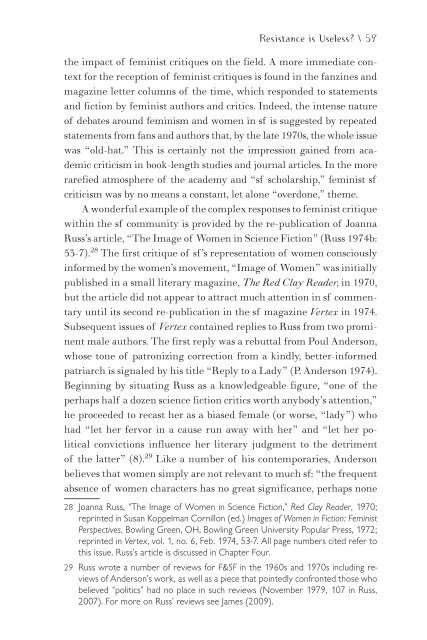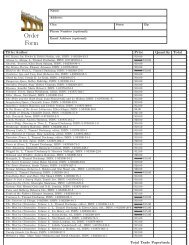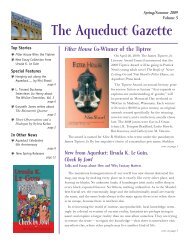Feminist Ca
Read Chapters Two and Three - Aqueduct Press
Read Chapters Two and Three - Aqueduct Press
- No tags were found...
Create successful ePaper yourself
Turn your PDF publications into a flip-book with our unique Google optimized e-Paper software.
Resistance is Useless? \ 59<br />
the impact of feminist critiques on the field. A more immediate context<br />
for the reception of feminist critiques is found in the fanzines and<br />
magazine letter columns of the time, which responded to statements<br />
and fiction by feminist authors and critics. Indeed, the intense nature<br />
of debates around feminism and women in sf is suggested by repeated<br />
statements from fans and authors that, by the late 1970s, the whole issue<br />
was “old-hat.” This is certainly not the impression gained from academic<br />
criticism in book-length studies and journal articles. In the more<br />
rarefied atmosphere of the academy and “sf scholarship,” feminist sf<br />
criticism was by no means a constant, let alone “overdone,” theme.<br />
A wonderful example of the complex responses to feminist critique<br />
within the sf community is provided by the re-publication of Joanna<br />
Russ’s article, “The Image of Women in Science Fiction” (Russ 1974b:<br />
53-7). 28 The first critique of sf’s representation of women consciously<br />
informed by the women’s movement, “Image of Women” was initially<br />
published in a small literary magazine, The Red Clay Reader, in 1970,<br />
but the article did not appear to attract much attention in sf commentary<br />
until its second re-publication in the sf magazine Vertex in 1974.<br />
Subsequent issues of Vertex contained replies to Russ from two prominent<br />
male authors. The first reply was a rebuttal from Poul Anderson,<br />
whose tone of patronizing correction from a kindly, better-informed<br />
patriarch is signaled by his title “Reply to a Lady” (P. Anderson 1974).<br />
Beginning by situating Russ as a knowledgeable figure, “one of the<br />
perhaps half a dozen science fiction critics worth anybody’s attention,”<br />
he proceeded to recast her as a biased female (or worse, “lady”) who<br />
had “let her fervor in a cause run away with her” and “let her political<br />
convictions influence her literary judgment to the detriment<br />
of the latter” (8). 29 Like a number of his contemporaries, Anderson<br />
believes that women simply are not relevant to much sf: “the frequent<br />
absence of women characters has no great significance, perhaps none<br />
28 Joanna Russ, “The Image of Women in Science Fiction,” Red Clay Reader, 1970;<br />
reprinted in Susan Koppelman Cornillon (ed.) Images of Women in Fiction: <strong>Feminist</strong><br />
Perspectives, Bowling Green, OH, Bowling Green University Popular Press, 1972;<br />
reprinted in Vertex, vol. 1, no. 6, Feb. 1974, 53-7. All page numbers cited refer to<br />
this issue. Russ’s article is discussed in Chapter Four.<br />
29 Russ wrote a number of reviews for F&SF in the 1960s and 1970s including reviews<br />
of Anderson’s work, as well as a piece that pointedly confronted those who<br />
believed “politics” had no place in such reviews (November 1979, 107 in Russ,<br />
2007). For more on Russ’ reviews see James (2009).




